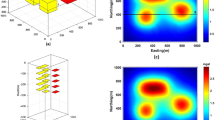Abstract
This paper discusses the inversion of nonlinear ill-posed problems. Such problems are solved through regularization and iteration and a major computational problem arises because the regularization parameter is not known a priori. In this paper we show that the regularization should be made up of two parts. A global regularization parameter is required to deal with the measurement noise, and a local regularization is needed to deal with the nonlinearity. We suggest the generalized cross validation (GCV) as a method to estimate the global regularization parameter and the damped Gauss-Newton to impose local regularization. Our algorithm is tested on the magnetotelluric problem.
In the second part of this paper we develop a methodology to implement our algorithm on large-scale problems. We show that hybrid regularization methods can successfully estimate the global regularization parameter. Our algorithm is tested on a large gravimetric problem.
Similar content being viewed by others
References
J. Altman, Smoothing data with correlated errors, Technical Report 280, Department of Statistics, Stanford University (1987).
L. Armijo, Minimization of a function having Lipschitz-continuous first partial derivatives, Pacific J. Math. 16 (1966) 1-3.
A. Bakushinsky and A. Goncharsky, Ill-Posed Problems: Theory and Applications (Kluwer Academic, 1994).
P.N. Brown and Y. Saad, Hybrid Krylov methods for nonlinear systems of equations, SIAM J. Sci. Statist. Comput. 11 (1990) 450-481.
S.C. Constable, R.L. Parker and C.G. Constable, Occam's inversion: A practical algorithm for generating smooth models from electromagnetic sounding data, Geophysics 52 (1987) 289-300.
R.S. Dembo, S.C. Eisenstat and T. Steihaug, Inexact Newton methods, SIAM J. Numer. Anal. 19 (1982) 400-408.
R.S. Dembo and T. Steihaug, Inexact Newton algorithms for large scale optimization, Math. Programming 26 (1983) 190-212.
J.E. Dennis and R.B. Schnabel, Numerical Methods for Unconstrained Optimization and Nonlinear Equations (SIAM, Philadelphia, PA, 1996).
L. Elden, Algorithms for the regularization of ill-conditioned least squares problems, BIT 17 (1977) 134-145.
L. Elden, A weighted pseudo-inverse, generalized singular values, and constrained least squares problems, BIT 22 (1982) 487-502.
L. Elden, Algorithms for the computation of functions defined on the solution of a discrete ill-posed problem, BIT 30 (1990) 466-483.
H.W. Engl, M. Hanke and A. Neubaur, Regularization of Inverse Problems (Kluwer Academic, Dordrecht, 1996).
C.G. Farquharson and D.W. Oldenburg, Inversion of time domain electromagnetic data for a horizontally layered Earth, Geophys. J. Int. 114 (1993) 433-442.
P.E. Gill, W. Murray and M.H. Wright, Practical Optimization (Academic Press, New York, 1981).
G.H. Golub, M. Heath and G. Whaba, Generalized cross-validation as a method for choosing a good ridge parameter, Technometrics 21 (1979) 215-223.
G.H. Golub and C.F. Van Loan, Matrix Computations, 2nd ed. (The Johns Hopkins University Press, Baltimore, MD, 1989).
G.H. Golub and U. Von Matt, Quadratically constrained least squares and quadratic problems, Numer. Math. 59 (1991) 561-580.
G.H. Golub and U. VonMatt, Generalized cross-validation for large scale problems (1997), to appear.
E. Haber, Numerical Strategies for the solution of inverse problems, Ph.D. thesis, The University of British Columbia (1997).
M. Hanke, Regularization with differential operators: An iterative approach, Numer. Funct. Anal. Optim. 13 (1992) 523-540.
M. Hanke and P.C. Hansen, Regularization methods for large scale problems, Surveys Math. Indust. 3 (1993) 253-315.
P.C. Hansen, Rank deficient and ill-posed problems, Ph.D. thesis, Technical University of Denmark (1995).
C.T. Kelley, Iterative Methods for Linear and Nonlinear Equations (SIAM, Philadelphia, PA, 1995).
O. Knoth, A globalization scheme for the generalized Gauss-Newton method, Numer. Math. 56(2) (1996) 591-603.
D.G. Luenberger, Optimization by Vector Space Methods (Wiley, New York, 1969).
W. Menke, Geophysical Data Analysis: Discrete Inverse Theory (Academic Press, Orlando, 1984).
D.W. Oldenburg, One-dimensional inversion of natural source magnetotelluric measurements, Geophysics 44 (1979) 1218-1244.
D.W. Oldenburg, P.R. McGillvary and R.G. Ellis, Generalized subspace methods for large scale inverse problems, Geophys. J. Int. 114 (1993) 12-20.
D.W. Oldenburg and Y. Li, Subspace linear inverse method, Inverse Problems 10 (1994) 915-935.
D.P. O'Leary and J.A. Simmons, A bidiagonalization-regularization procedure for large scale regularization of ill-posed problems, SIAM J. Sci. Statist. Comput. 2 (1981) 474-489.
R.L. Parker, Geophysical Inverse Theory (Princeton University Press, Princeton, NJ, 1994).
B.N. Parlet, The Symmetric Eigenvalue Problem (Prentice-Hall, Englewood Cliffs, NJ, 1980).
Y. Saad, Iterative Methods for Sparse Linear Systems (PWS, 1996).
J.A. Scales and M.L. Smith, Introductory Geophysical Inverse Theory (Samizdat, 1994).
J.T. Smith and J.R. Booker, Rapid inversion of two and three dimensional magnetotelluric data, J. Geophys. Res. 96 (1991) 3905-3922.
A. Tarantola and B. Valette, Generalized nonlinear inverse problems solved using the least squares criterion, Rev. Geophys. Space Phys. 20(2) (1982) 219-232.
A. Tarantola, Inverse Problem Theory (Elsevier Science, Amsterdam, 1987).
A.N. Tikhonov and V.Y. Arsenin, Solutions of Ill-Posed Problems (Wiley, New York, 1977).
J.M. Varah, Pitfalls in numerical solutions of linear ill-posed problems, SIAM J. Sci. Comput. 4 (1983) 164-176.
G. Whaba, Practical approximate solutions to linear operator equations when the data are noisy, SIAM J. Numer Anal. 14 (1977) 651-667.
G. Whaba, Spline Models for Observational Data (SIAM, Philadelphia, PA, 1990).
G. Whaba and S. O'sullivan, A cross validated Bayesian retrieval algorithm for non-linear remote sensing experiments, J. Comput. Physics 59 (1985) 441-455.
S.H. Ward and G.W. Hohmann, Electromagnetic theory for geophysical applications, Electromagnetic Methods Appl. Geophysics 1 (1988) 131-311.
K.P. Whittall and D.W. Oldenburg, Inversion of Magnetotelluric Data for a One Dimensional Conductivity, SEG Monograph, Vol. 5 (1992).
J. Zhang, R.L. Mackie and T.R. Madden, 3-D resistivity forward modeling and inversion using conjugate gradients, Geophysics 60(5) (1995) 1313-1325.
Author information
Authors and Affiliations
Rights and permissions
About this article
Cite this article
Haber, E., Oldenburg, D. A GCV based method for nonlinear ill-posed problems. Computational Geosciences 4, 41–63 (2000). https://doi.org/10.1023/A:1011599530422
Issue Date:
DOI: https://doi.org/10.1023/A:1011599530422




